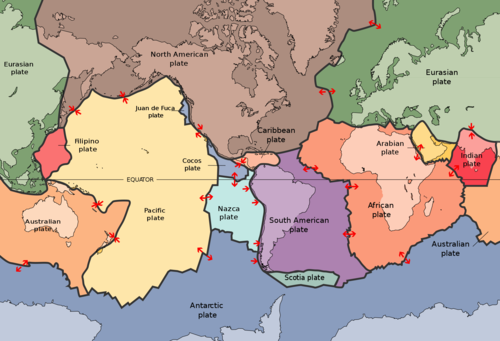
The 15 major plates with subduction and divergent boundaries marked.
Now it is possible to put these elements together into a comprehensive picture. The continents sit in large plates, which include at least some oceanic crust.[1] These rigid plates subdivide the entire surface of the planet. They move around on top of a mobile layer known as the mantle. The plates pull apart at rifts, they collide in subduction zones and mountain ranges and they can also slide past each other.
Plate boundaries are the site of most global tectonic processes and events, including earthquakes, volcanoes and the construction of new oceanic and continental crust.
Because ocean crust is created at rifts and then disappears back into the mantle at subduction zones, it is being constantly recycled, roughly every 200 million years.[2] It is this process which moves the continents that sit in the plates.
No plate is purely continental and each contains some ocean crust. The Pacific plate is almost all oceanic.
This recycling also explained another puzzle that had been raised by scientists. Why hadn't the accumulated sediment from rivers filled in the oceans over time? The recycling of ocean crust back into the mantle solved this problem: the sediment melts back into the mantle with the ocean crust.
Author: Tom Brown
Copyright: public domain
Date last modified: 11th Oct 2011
Peer-review status: Not yet peer-reviewed
plates.png: source: Wikipedia